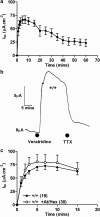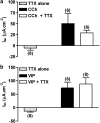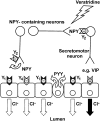The regulation of veratridine-stimulated electrogenic ion transport in mouse colon by neuropeptide Y (NPY), Y1 and Y2 receptors
- PMID: 16100526
- PMCID: PMC1751203
- DOI: 10.1038/sj.bjp.0706368
The regulation of veratridine-stimulated electrogenic ion transport in mouse colon by neuropeptide Y (NPY), Y1 and Y2 receptors
Abstract
1 Neuropeptide Y (NPY) is a prominent enteric neuropeptide with prolonged antisecretory effects in mammalian intestine. Veratridine depolarises neurons consequently causing epithelial anion secretion across mouse colon mucosa. Our aim was to characterise functionally, veratridine-stimulated mucosal responses and to determine the roles for NPY, Y(1), and Y(2) receptors in modulating these neurogenic effects. 2 Colon mucosae (with intact submucous innervation) from wild-type mice (+/+) and knockouts lacking either NPY (NPY-/-), Y(1)-/- or Y(2)-/- were placed in Ussing chambers and voltage clamped at 0 mV. Veratridine-stimulated short-circuit current (I(sc)) responses in +/+, Y(1) or Y(2) antagonist pretreated +/+ colon, Y(1)-/- and NPY-/- colon were insensitive to cholinergic blockade by atropine (At; 1 microM) and hexamethonium (Hex; 10 microM). Tetrodotoxin (TTX, 100 nM) abolished veratridine responses, but had no effect upon carbachol (CCh) or vasoactive intestinal polypeptide (VIP)-induced secretory responses. 3 To establish the functional roles for Y(1) and Y(2) receptors, +/+ tissues were pretreated with either the Y(1) or Y(2) receptor antagonist (BIBO3304 (300 nM) or BIIE0246 (1 microM), respectively) and veratridine responses were compared with those from Y(1)-/- or Y(2)-/- colon. Neither BIBO3304 nor Y(1)-/- altered veratridine-induced secretion, but Y(1) agonist responses were abolished in both preparations. In contrast, the Y(2) antagonist BIIE0246 significantly amplified veratridine responses in +/+ mucosa. Unexpectedly, NPY-/- colon exhibited significantly attenuated veratridine responses (between 1 and 5 min). 4 We demonstrate that electrogenic veratridine responses in mouse colon are noncholinergic and that NPY can act directly upon epithelia, a Y(1) receptor effect. The enhanced veratridine response observed in +/+ tissue following BIIE0246, indicates that Y(2) receptors are located on submucosal neurons and that their activation by NPY will inhibit enteric noncholinergic secretory neurotransmission. 5 We also demonstrate Y(1) and Y(2) receptor-mediated antisecretory tone in +/+ colon and show selective loss of each in Y(1) and Y(2) null colon respectively. In NPY-/- tissue, only Y(1)-mediated tone was present, this presumably being mediated by endogenous endocrine peptide YY. Y(2) tone was absent from NPY-/- (and Y(2)-/-) colon and we conclude that NPY activation of neuronal Y(2) receptors attenuates secretory neurotransmission thereby providing an absorptive electrolyte tone in isolated colon.
Figures









References
-
- ALLESCHER H.D., KURJAK M., HUBER A., TRUDRUNG P., SCHUSDZIARRA V. Regulation of VIP release from rat enteric nerve terminals: evidence for a stimulatory effect of NO. Am. J. Physiol. 1996;271:G568–G574. - PubMed
-
- BATTERHAM R.L., COWLEY M.A., SMALL C.J., HERZOG H., COHEN M.A., DAKIN C.L., WREN A.M., BRYNES A.E., LOW M.J., GHATEI M.A., CONE R.D., BLOOM S.R. Gut hormone PYY(3–36) physiologically inhibits food intake. Nature. 2002;418:650–654. - PubMed
-
- BELAI A., BURNSTOCK G. Release of calcitonin gene-related peptide from rat enteric nerves is Ca2+-dependent but is not induced by K+ depolarization. Regul. Pept. 1988;23:227–235. - PubMed
-
- CATTERALL W.A. Neurotoxins that act on voltage-sensitive sodium channels in excitable membranes. Annu. Rev. Pharmacol. Toxicol. 1980;20:15–43. - PubMed
-
- COX H.M., CUTHBERT A.W. Neuropeptide Y antagonises secretagogue evoked chloride transport in rat jejunal epithelium. Pflugers Arch. 1988;413:38–42. - PubMed
Publication types
MeSH terms
Substances
LinkOut - more resources
Full Text Sources
Other Literature Sources
Molecular Biology Databases
Research Materials
Miscellaneous

